Shuqiang Jiang
Embodied Arena: A Comprehensive, Unified, and Evolving Evaluation Platform for Embodied AI
Sep 18, 2025Abstract:Embodied AI development significantly lags behind large foundation models due to three critical challenges: (1) lack of systematic understanding of core capabilities needed for Embodied AI, making research lack clear objectives; (2) absence of unified and standardized evaluation systems, rendering cross-benchmark evaluation infeasible; and (3) underdeveloped automated and scalable acquisition methods for embodied data, creating critical bottlenecks for model scaling. To address these obstacles, we present Embodied Arena, a comprehensive, unified, and evolving evaluation platform for Embodied AI. Our platform establishes a systematic embodied capability taxonomy spanning three levels (perception, reasoning, task execution), seven core capabilities, and 25 fine-grained dimensions, enabling unified evaluation with systematic research objectives. We introduce a standardized evaluation system built upon unified infrastructure supporting flexible integration of 22 diverse benchmarks across three domains (2D/3D Embodied Q&A, Navigation, Task Planning) and 30+ advanced models from 20+ worldwide institutes. Additionally, we develop a novel LLM-driven automated generation pipeline ensuring scalable embodied evaluation data with continuous evolution for diversity and comprehensiveness. Embodied Arena publishes three real-time leaderboards (Embodied Q&A, Navigation, Task Planning) with dual perspectives (benchmark view and capability view), providing comprehensive overviews of advanced model capabilities. Especially, we present nine findings summarized from the evaluation results on the leaderboards of Embodied Arena. This helps to establish clear research veins and pinpoint critical research problems, thereby driving forward progress in the field of Embodied AI.
Sim-to-Real Transfer via 3D Feature Fields for Vision-and-Language Navigation
Jun 14, 2024



Abstract:Vision-and-language navigation (VLN) enables the agent to navigate to a remote location in 3D environments following the natural language instruction. In this field, the agent is usually trained and evaluated in the navigation simulators, lacking effective approaches for sim-to-real transfer. The VLN agents with only a monocular camera exhibit extremely limited performance, while the mainstream VLN models trained with panoramic observation, perform better but are difficult to deploy on most monocular robots. For this case, we propose a sim-to-real transfer approach to endow the monocular robots with panoramic traversability perception and panoramic semantic understanding, thus smoothly transferring the high-performance panoramic VLN models to the common monocular robots. In this work, the semantic traversable map is proposed to predict agent-centric navigable waypoints, and the novel view representations of these navigable waypoints are predicted through the 3D feature fields. These methods broaden the limited field of view of the monocular robots and significantly improve navigation performance in the real world. Our VLN system outperforms previous SOTA monocular VLN methods in R2R-CE and RxR-CE benchmarks within the simulation environments and is also validated in real-world environments, providing a practical and high-performance solution for real-world VLN.
FoodSky: A Food-oriented Large Language Model that Passes the Chef and Dietetic Examination
Jun 11, 2024



Abstract:Food is foundational to human life, serving not only as a source of nourishment but also as a cornerstone of cultural identity and social interaction. As the complexity of global dietary needs and preferences grows, food intelligence is needed to enable food perception and reasoning for various tasks, ranging from recipe generation and dietary recommendation to diet-disease correlation discovery and understanding. Towards this goal, for powerful capabilities across various domains and tasks in Large Language Models (LLMs), we introduce Food-oriented LLM FoodSky to comprehend food data through perception and reasoning. Considering the complexity and typicality of Chinese cuisine, we first construct one comprehensive Chinese food corpus FoodEarth from various authoritative sources, which can be leveraged by FoodSky to achieve deep understanding of food-related data. We then propose Topic-based Selective State Space Model (TS3M) and the Hierarchical Topic Retrieval Augmented Generation (HTRAG) mechanism to enhance FoodSky in capturing fine-grained food semantics and generating context-aware food-relevant text, respectively. Our extensive evaluations demonstrate that FoodSky significantly outperforms general-purpose LLMs in both chef and dietetic examinations, with an accuracy of 67.2% and 66.4% on the Chinese National Chef Exam and the National Dietetic Exam, respectively. FoodSky not only promises to enhance culinary creativity and promote healthier eating patterns, but also sets a new standard for domain-specific LLMs that address complex real-world issues in the food domain. An online demonstration of FoodSky is available at http://222.92.101.211:8200.
DiffGen: Robot Demonstration Generation via Differentiable Physics Simulation, Differentiable Rendering, and Vision-Language Model
May 12, 2024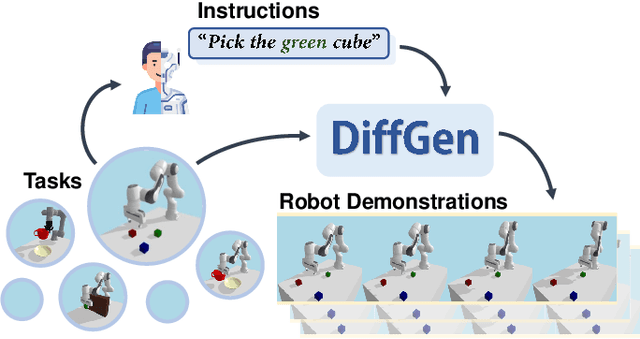

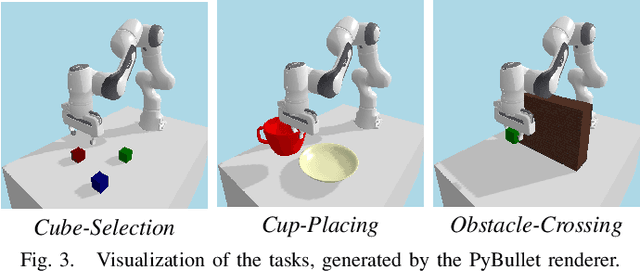
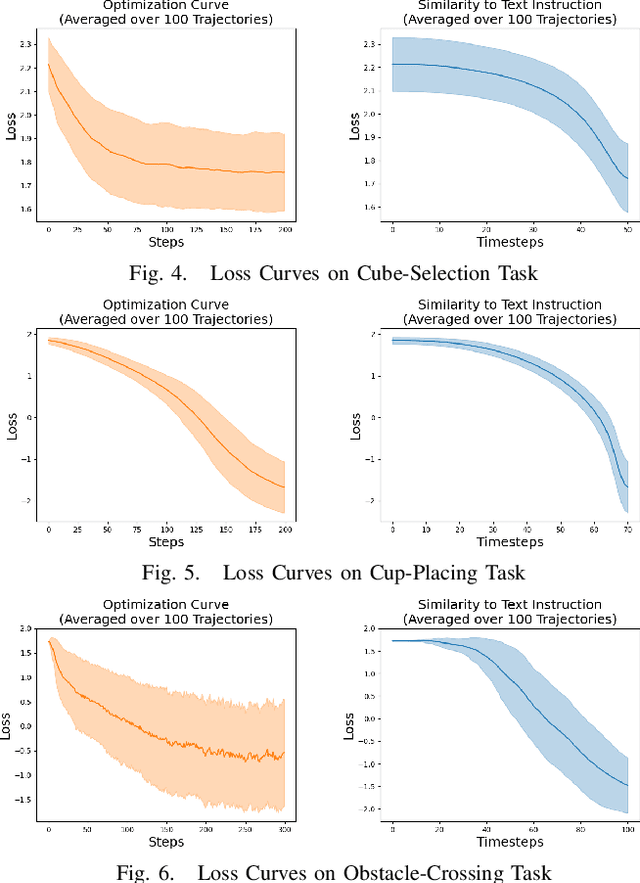
Abstract:Generating robot demonstrations through simulation is widely recognized as an effective way to scale up robot data. Previous work often trained reinforcement learning agents to generate expert policies, but this approach lacks sample efficiency. Recently, a line of work has attempted to generate robot demonstrations via differentiable simulation, which is promising but heavily relies on reward design, a labor-intensive process. In this paper, we propose DiffGen, a novel framework that integrates differentiable physics simulation, differentiable rendering, and a vision-language model to enable automatic and efficient generation of robot demonstrations. Given a simulated robot manipulation scenario and a natural language instruction, DiffGen can generate realistic robot demonstrations by minimizing the distance between the embedding of the language instruction and the embedding of the simulated observation after manipulation. The embeddings are obtained from the vision-language model, and the optimization is achieved by calculating and descending gradients through the differentiable simulation, differentiable rendering, and vision-language model components, thereby accomplishing the specified task. Experiments demonstrate that with DiffGen, we could efficiently and effectively generate robot data with minimal human effort or training time.
Lookahead Exploration with Neural Radiance Representation for Continuous Vision-Language Navigation
Apr 02, 2024
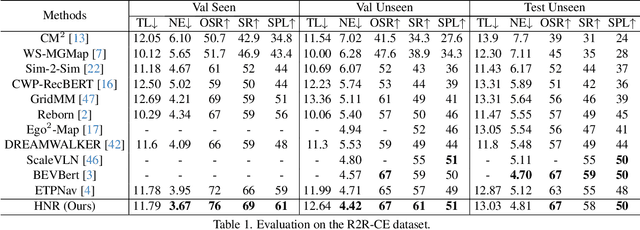


Abstract:Vision-and-language navigation (VLN) enables the agent to navigate to a remote location following the natural language instruction in 3D environments. At each navigation step, the agent selects from possible candidate locations and then makes the move. For better navigation planning, the lookahead exploration strategy aims to effectively evaluate the agent's next action by accurately anticipating the future environment of candidate locations. To this end, some existing works predict RGB images for future environments, while this strategy suffers from image distortion and high computational cost. To address these issues, we propose the pre-trained hierarchical neural radiance representation model (HNR) to produce multi-level semantic features for future environments, which are more robust and efficient than pixel-wise RGB reconstruction. Furthermore, with the predicted future environmental representations, our lookahead VLN model is able to construct the navigable future path tree and select the optimal path via efficient parallel evaluation. Extensive experiments on the VLN-CE datasets confirm the effectiveness of our method.
Synthesizing Knowledge-enhanced Features for Real-world Zero-shot Food Detection
Feb 14, 2024Abstract:Food computing brings various perspectives to computer vision like vision-based food analysis for nutrition and health. As a fundamental task in food computing, food detection needs Zero-Shot Detection (ZSD) on novel unseen food objects to support real-world scenarios, such as intelligent kitchens and smart restaurants. Therefore, we first benchmark the task of Zero-Shot Food Detection (ZSFD) by introducing FOWA dataset with rich attribute annotations. Unlike ZSD, fine-grained problems in ZSFD like inter-class similarity make synthesized features inseparable. The complexity of food semantic attributes further makes it more difficult for current ZSD methods to distinguish various food categories. To address these problems, we propose a novel framework ZSFDet to tackle fine-grained problems by exploiting the interaction between complex attributes. Specifically, we model the correlation between food categories and attributes in ZSFDet by multi-source graphs to provide prior knowledge for distinguishing fine-grained features. Within ZSFDet, Knowledge-Enhanced Feature Synthesizer (KEFS) learns knowledge representation from multiple sources (e.g., ingredients correlation from knowledge graph) via the multi-source graph fusion. Conditioned on the fusion of semantic knowledge representation, the region feature diffusion model in KEFS can generate fine-grained features for training the effective zero-shot detector. Extensive evaluations demonstrate the superior performance of our method ZSFDet on FOWA and the widely-used food dataset UECFOOD-256, with significant improvements by 1.8% and 3.7% ZSD mAP compared with the strong baseline RRFS. Further experiments on PASCAL VOC and MS COCO prove that enhancement of the semantic knowledge can also improve the performance on general ZSD. Code and dataset are available at https://github.com/LanceZPF/KEFS.
SeeDS: Semantic Separable Diffusion Synthesizer for Zero-shot Food Detection
Oct 07, 2023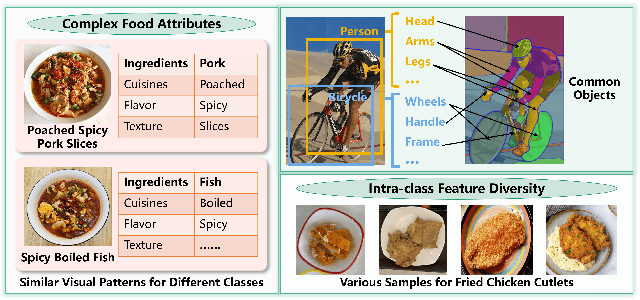


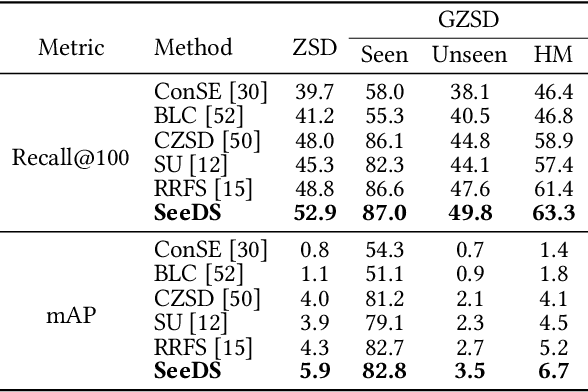
Abstract:Food detection is becoming a fundamental task in food computing that supports various multimedia applications, including food recommendation and dietary monitoring. To deal with real-world scenarios, food detection needs to localize and recognize novel food objects that are not seen during training, demanding Zero-Shot Detection (ZSD). However, the complexity of semantic attributes and intra-class feature diversity poses challenges for ZSD methods in distinguishing fine-grained food classes. To tackle this, we propose the Semantic Separable Diffusion Synthesizer (SeeDS) framework for Zero-Shot Food Detection (ZSFD). SeeDS consists of two modules: a Semantic Separable Synthesizing Module (S$^3$M) and a Region Feature Denoising Diffusion Model (RFDDM). The S$^3$M learns the disentangled semantic representation for complex food attributes from ingredients and cuisines, and synthesizes discriminative food features via enhanced semantic information. The RFDDM utilizes a novel diffusion model to generate diversified region features and enhances ZSFD via fine-grained synthesized features. Extensive experiments show the state-of-the-art ZSFD performance of our proposed method on two food datasets, ZSFooD and UECFOOD-256. Moreover, SeeDS also maintains effectiveness on general ZSD datasets, PASCAL VOC and MS COCO. The code and dataset can be found at https://github.com/LanceZPF/SeeDS.
GridMM: Grid Memory Map for Vision-and-Language Navigation
Jul 25, 2023



Abstract:Vision-and-language navigation (VLN) enables the agent to navigate to a remote location following the natural language instruction in 3D environments. To represent the previously visited environment, most approaches for VLN implement memory using recurrent states, topological maps, or top-down semantic maps. In contrast to these approaches, we build the top-down egocentric and dynamically growing Grid Memory Map (i.e., GridMM) to structure the visited environment. From a global perspective, historical observations are projected into a unified grid map in a top-down view, which can better represent the spatial relations of the environment. From a local perspective, we further propose an instruction relevance aggregation method to capture fine-grained visual clues in each grid region. Extensive experiments are conducted on both the REVERIE, R2R, SOON datasets in the discrete environments, and the R2R-CE dataset in the continuous environments, showing the superiority of our proposed method.
KERM: Knowledge Enhanced Reasoning for Vision-and-Language Navigation
Mar 28, 2023Abstract:Vision-and-language navigation (VLN) is the task to enable an embodied agent to navigate to a remote location following the natural language instruction in real scenes. Most of the previous approaches utilize the entire features or object-centric features to represent navigable candidates. However, these representations are not efficient enough for an agent to perform actions to arrive the target location. As knowledge provides crucial information which is complementary to visible content, in this paper, we propose a Knowledge Enhanced Reasoning Model (KERM) to leverage knowledge to improve agent navigation ability. Specifically, we first retrieve facts (i.e., knowledge described by language descriptions) for the navigation views based on local regions from the constructed knowledge base. The retrieved facts range from properties of a single object (e.g., color, shape) to relationships between objects (e.g., action, spatial position), providing crucial information for VLN. We further present the KERM which contains the purification, fact-aware interaction, and instruction-guided aggregation modules to integrate visual, history, instruction, and fact features. The proposed KERM can automatically select and gather crucial and relevant cues, obtaining more accurate action prediction. Experimental results on the REVERIE, R2R, and SOON datasets demonstrate the effectiveness of the proposed method.
Deep Learning for Logo Detection: A Survey
Oct 10, 2022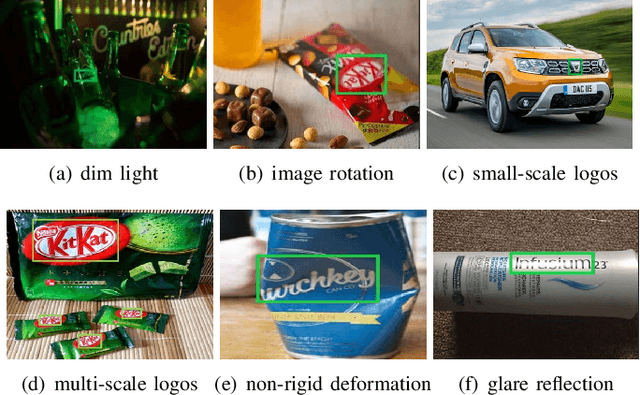

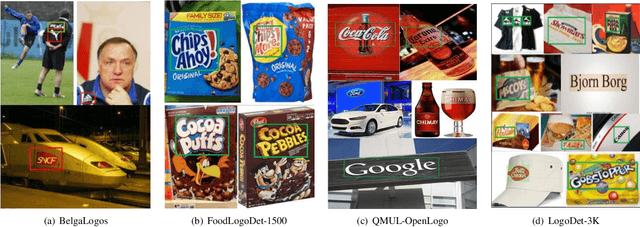
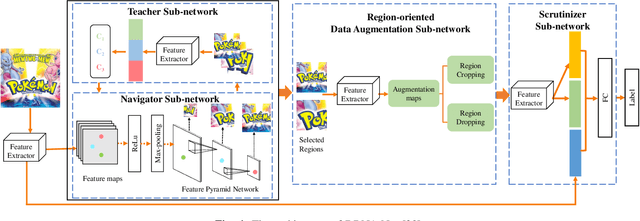
Abstract:When logos are increasingly created, logo detection has gradually become a research hotspot across many domains and tasks. Recent advances in this area are dominated by deep learning-based solutions, where many datasets, learning strategies, network architectures, etc. have been employed. This paper reviews the advance in applying deep learning techniques to logo detection. Firstly, we discuss a comprehensive account of public datasets designed to facilitate performance evaluation of logo detection algorithms, which tend to be more diverse, more challenging, and more reflective of real life. Next, we perform an in-depth analysis of the existing logo detection strategies and the strengths and weaknesses of each learning strategy. Subsequently, we summarize the applications of logo detection in various fields, from intelligent transportation and brand monitoring to copyright and trademark compliance. Finally, we analyze the potential challenges and present the future directions for the development of logo detection to complete this survey.
 Add to Chrome
Add to Chrome Add to Firefox
Add to Firefox Add to Edge
Add to Edge